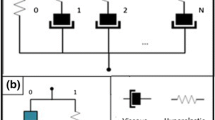Abstract
Self-expanding stents or stentgrafts made from Nitinol superelastic alloy are widely used for a less invasive treatment of disease-induced localized flow constriction in the cardiovascular system. The therapy is based on insertion of a stent into a blood vessel to maintain the inner diameter of the vessel; it provides highly effective results at minimal cost and with reduced hospital stays. However, since stent is an external mechanical healing tool implemented into human body for quite a long time, information on the mechanical performance of it is of fundamental importance with respect to patient’s safety and comfort. Advantageously, computational structural analysis can provide valuable information on the response of the product in an environment where in vivo experimentation is extremely expensive or impossible. With this motivation, a numerical model of a particular braided self-expanding stent was developed. As a reasonable approximation substantially reducing computational demands, the stent was considered to be composed of a set of helical springs with specific constrains reflecting geometry of the structure. An advanced constitutive model for NiTi-based shape memory alloys including R-phase transition was employed in analysis. Comparison to measurements shows a very good match between the numerical solution and experimental results. Relation between diameter of the stent and uniform radial pressure on its surface is estimated. Information about internal phase and stress state of the material during compression loading provided by the model is used to estimate fatigue properties of the stent during cyclic loading.








Similar content being viewed by others
Notes
To be strictly rigorous, there is another type of very slight deviations from the ideal helix in the real stent. Since wire crossings slightly displace the wire from its ideal position on a helix, the helical springs are not smooth but a little bit “wavy” along the wounding direction. However, we neglect these subtle deviations from idealized geometry and justify this inaccuracy a posteriori by very good agreement between experimental and computational results.
Let us note that by this simplification we avoid classical handling of contact between springs which would be numerically much more demanding.
References
L.G. Machado and M.A. Savi, Medical Applications of Shape Memory Alloys, Braz. J. Med. Biol. Res., 2003, 36, p 683–691
T. Duerig, D.E. Tolomeo, and M. Wholey, An Overview of Superelastic Stent Design, Minim. Invasive Ther. Allied Technol., 2000, 9(3-4), p 235–246
D. Stoeckel, A. Pelton, and T. Duerig, Self-Expanding Nitinol Stents: Material and Design Considerations, Eur. Radiol., 2004, 14, p 292–301
Ella-CS s.r.o., http://www.ellacs.eu/stents.html. Accessed 3 Apr 2014
K. Otsuka and X. Ren, Physical Metallurgy of Ti-Ni-Based Shape Memory Alloys, Prog. Mater. Sci., 2005, 50, p 511–678
P. Sittner, M. Landa, P. Lukas, and V. Novak, R-Phase Transformation Phenomena in Thermomechanically Loaded NiTi Polycrystals, Mech. Mater., 2006, 38, p 475–492
F. Auricchio, M. Conti, M. DeBeule, G. DeSantis, and B. Verhegghe, Carotid Artery Stenting Simulation: From Patient-Specific Images to Finite Element Analysis, Med. Eng. Phys., 2011, 33, p 281–289
M. Grujicic, B. Pandurangan, A. Arakere, and J.S. Snipes, Fatigue-Life Computational Analysis for the Self-Expanding Endovascular Nitinol Stents, J. Mater. Eng. Perform., 2012, 21(11), p 2218–2230
S.M. Harvey, Nitinol Stent Fatigue in a Peripheral Human Artery Subjected to Pulsatile and Articulation Loading, J. Mater. Eng. Perform., 2011, 20(4-5), p 697–705
F. Auricchio and L. Petrini, A Three-Dimensional Model Describing Stress-Temperature Induced Solid Phase Transformations: Solution Algorithm and Boundary Value Problems, Int. J. Numer. Methods Eng., 2004, 61, p 807–836
D.J. Hartl, G. Chatzigeorgiou, and D.C. Lagoudas, Three-Dimensional Modeling and Numerical Analysis of Rate-Dependent Irrecoverable Deformation in Shape Memory Alloys, Int. J. Plast., 2010, 26, p 1485–1507
S. Stupkiewicz and H. Petryk, A Robust Model of Pseudoelasticity in Shape Memory Alloys, Int. J. Numer. Methods Eng., 2013, 93, p 747–769
K. Hirmanova, J. Pilch, J. Racek, P. Sittner, L. Recman, and P. Sedlak, Physical Simulation of the Random Failure of Implanted Braided NiTi Stents, Proceedings of the International Conference on Shape Memory and Superelastic Technologies, May 20-24, Prague, Czech Republic, ASM International, 2013, p 344-345.
P. Sedlak, M. Frost, B. Benesova, P. Sittner, T. Ben, and Zineb, Thermomechanical Model for NiTi-Based Shape Memory Alloys Including R-Phase and Material Anisotropy Under Multi-Axial Loadings, Int. J. Plast., 2012, 39, p 132–151
P. Sedlak, M. Frost, A. Kruisova, et al. Simulations of Mechanical Response of Superelastic NiTi Helical Spring and Its Relation to Fatigue Resistance, J. Mater. Eng. Perform, 2014. doi:10.1007/s11665-014-0906-y
Abaqus Reference Manuals, SIMULIA Inc, USA, 2010.
Q.S. Nguyen, Stability and Nonlinear Solid Mechanics, Wiley, New York, 2000, p 17–40
M. Frost, B. Benesova, and P. Sedlak, A Microscopically Motivated Constitutive Model for Shape Memory Alloys: Formulation, Analysis and Computations, Math. Mech. Solids, 2014. doi:10.1177/1081286514522474
Acknowledgments
We would like to thank to Dr. K. Volenec (Ella-CS) for providing the investigated stent and to Prof. T. Ben Zineb for providing access to CLCM computation cluster (Centre Lorrain de calcul haute performance en mécanique, France). This work has been conducted with institutional support RVO:61388998 of IT ASCR, v.v.i. The research has also been supported by the Grant Agency of the Czech Republic through grant Projects No. 13-13616S, 14-15264S, and 14-28306P, and by the Academy of Sciences of the Czech Republic through internal Project No. M100761203. All the supports are gratefully acknowledged.
Author information
Authors and Affiliations
Corresponding author
Additional information
This article is an invited paper selected from presentations at the International Conference on Shape Memory and Superelastic Technologies 2013, held May 20-24, 2013, in Prague, Czech Republic, and has been expanded from the original presentation.
Rights and permissions
About this article
Cite this article
Frost, M., Sedlák, P., Kruisová, A. et al. Simulations of Self-Expanding Braided Stent Using Macroscopic Model of NiTi Shape Memory Alloys Covering R-Phase. J. of Materi Eng and Perform 23, 2584–2590 (2014). https://doi.org/10.1007/s11665-014-0966-z
Received:
Revised:
Published:
Issue Date:
DOI: https://doi.org/10.1007/s11665-014-0966-z




